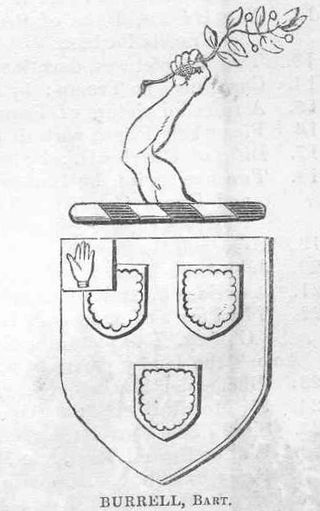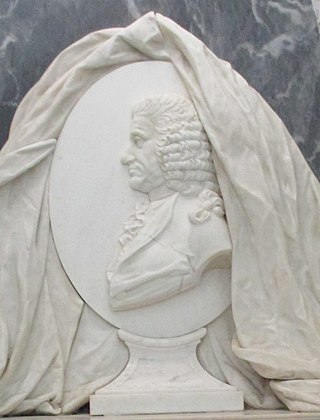Related Research Articles
There have been two baronetcies created for persons with the same surname - Wynn, these baronetcies descended from north Wales.

Viscount Maynard, of Easton Lodge in the County of Essex, was a title in the Peerage of Great Britain. It was created in 1766 for Charles Maynard, 6th Baron Maynard, Lord-Lieutenant of Suffolk. He was made Baron Maynard, of Much Easton in the County of Essex, at the same time, also in the Peerage of Great Britain. Both titles were created with special remainder, failing male issue of his own, to his kinsman Sir William Maynard, 4th Baronet. The 1st Viscount was unmarried and on his death in 1775 the baronetcy of Easton Parva, the Irish barony of Maynard created in 1620 and the English barony of Maynard created in 1628 became extinct. He was succeeded in the barony of 1766 and the viscountcy according to the special remainder by his kinsman Sir Charles Maynard, 5th Baronet, who became the 2nd Viscount. The latter was succeeded by his nephew, the 3rd Viscount, who served as Lord-Lieutenant of Essex. He had no surviving male issue and on his death in 1865 the baronetcy, barony and viscountcy became extinct. His granddaughter, Daisy Maynard, daughter of Colonel Charles Henry Maynard and future wife of Francis Greville, 5th Earl of Warwick, succeeded to most of the Maynard estates.
Baron Gwydyr, of Gwydyr in the County of Carnarvon, was a title in the Peerage of Great Britain. It was created on 16 June 1796 for Sir Peter Burrell, 2nd Baronet, who had earlier represented Boston and Haslemere in the House of Commons. The Burrell Baronetcy, of West Grinstead Park in the County of Sussex, had been created in the Baronetage of Great Britain on 5 July 1766 for his great-uncle Merrik Burrell, with remainder to the latter's nephew Peter Burrell. Merrik Burrell had previously represented Marlow, Grampound, Haslemere and Great Bedwyn in Parliament. Lord Gwydyr married Priscilla Bertie, 21st Baroness Willoughby de Eresby, herself a descendant of the Aberffraw legacy through her grandmother Mary Wynn. They were both succeeded by their eldest son, Peter Drummond-Burrell, 22nd Baron Willoughby de Eresby. On the death in 1865 of his son, the two titles separated. The Barony of Willoughby de Eresby fell into abeyance between the late Baron's sisters while the baronetcy and barony of Gwydyr were inherited by his cousin, the fourth Baron. He was the son of the Honourable Lindsey Merrik Peter Burrell, younger son of the first Baron. The baronetcy and barony became extinct on the death of his son, the fifth Baron, on 13 February 1915.

Baron Calthorpe, of Calthorpe in the County of Norfolk, was a title in the Peerage of Great Britain. It was created in 1796 for Sir Henry Gough, 2nd Baronet, who had previously represented Bramber in Parliament. Born Henry Gough, he had assumed the additional surname of Calthorpe upon inheriting the Elvetham and Norfolk estates of his maternal uncle, Sir Henry Calthorpe, in 1788. The Baronetcy, of Edgbaston in the County of Warwick, had been created in the Baronetage of Great Britain on 6 April 1728 for Lord Calthorpe's father Henry Gough, who represented Totnes and Bramber in the House of Commons. He was the husband of Barbara, daughter of Reynolds Calthorpe. Three of Lord Calthorpe's sons, the second, third and fourth Barons, both succeeded in the titles. The latter sat as a Member of Parliament for Hindon and Bramber. In 1845 he assumed by Royal licence for himself the surname of Gough only. His eldest son, the fifth Baron, represented East Worcestershire in Parliament as a Liberal. The fifth Baron's younger brother, the seventh Baron, was a Lieutenant-General in the Army. The latter's son, the eighth Baron, was succeeded by his grandson, the ninth Baron. The titles became extinct on the death of the ninth Baron's younger brother, the tenth Baron, in 1997.
Sir Peter Burrell, 1st Baron Gwydyr PC featured in English politics at the end of the 18th century, but he was best known for his involvement in cricket, particularly his part in the foundation of Marylebone Cricket Club in 1787.

Algernon Percy, 1st Earl of Beverley FSA, styled Lord Algernon Percy between 1766 and 1786 and known as the Lord Lovaine between 1786 and 1790, was a British politician who sat in the House of Commons from 1774 to 1786 when he succeeded to the Peerage.

There has been one baronetcy created for a person with the surname Burrell. Another baronetcy passed by special remainder to the Burrell family.
There have been four baronetcies for persons with the surname Blake, one in the Baronetage of Ireland, two in the Baronetage of Great Britain and one in the Baronetage of the United Kingdom. Two of the creations are extant as of 2010. The Blake Baronetcy, of Menlough in the County of Galway, was created in the Baronetage of Ireland on 10 July 1622 for Valentine Blake, Mayor of Galway in 1611 and 1630 and a member of the Irish House of Commons for County Galway. His grandfather Thomas Blake had preceded him as Mayor. The second Baronet was a member of the Irish Parliament for Galway Borough. The third Baronet represented both County Galway and Galway Borough in Parliament. The sixth Baronet was a member of the Irish House of Commons for County Galway. He was the first Catholic gentlemen of distinction to join William of Orange. The twelfth Baronet represented Galway Borough in the British House of Commons. The fourteenth Baronet was high sheriff of County Galway in 1872. See also the Blake Baronetcy of Twizell Castle below.

Sir Merrik Burrell, 1st Baronet was a British politician.
Peter Burrell FRS was a British politician and barrister.
John Rushout, 1st Baron Northwick was a British politician and Member of Parliament (MP) for Evesham.

The Pigot Baronetcy, of Patshull Hall in the County of Stafford, is a title in the Baronetage of Great Britain. It was created on 5 December 1764 for the politician and colonial administrator George Pigot, with remainder to his brothers General Robert Pigot and Admiral Hugh Pigot, and remains extant. On 19 January 1766 Pigot was further honoured when he was raised to the Peerage of Ireland as Baron Pigot, with normal remainder to the heirs male of his body. Lord Pigot was unmarried and on his death in 1777 the barony became extinct. He was succeeded in the baronetcy according to the special remainder by his brother, Robert, the second Baronet. He was a distinguished soldier.
There have been seven baronetcies created for persons with the surname Sinclair, six in the Baronetage of Nova Scotia and one in the Baronetage of Great Britain. Four of the creations are extant as of 2008.

Peter Robert Burrell, 4th Baron Gwydyr was High Sheriff of Suffolk in 1858. In addition, he was Secretary to the Lord Great Chamberlain, High Steward of Ipswich, and Chairman of Quarter Sessions, Suffolk. Burrell succeeded to the title of 4th Baron Gwydyr, of Gwydyr, County Carnarvon, on 26 August 1870.

Willoughby Merrik Campbell Burrell, 5th Baron Gwydyr, FRGS was a British Army officer and peer.

Sir Charles Merrik Burrell, 3rd Baronet was an English Conservative politician, who represented the seat of New Shoreham for fifty-six years, becoming Father of the House of Commons.

Sir William Burrell was an English antiquarian.
Charles Maynard, 1st Viscount Maynard, styled Charles Maynard between 1699 and 1745 and known as The Lord Maynard between 1745 and 1766, was a British peer. He served as Lord-Lieutenant of Suffolk between 1763 and 1769.
Sir Roger Mostyn, 5th Baronet was a Welsh landowner and politician who sat in the House of Commons for 38 years from 1758 to 1796.
Raymond was launched in 1782 as an East Indiaman for the British East India Company (EIC). She made six voyages for the EIC and participated as a transport in Admiral Hugh Cloberry Christian's expedition in 1795–96 to the West Indies. The French captured her in 1798. American owners purchased her, renamed her Orion, and sailed her from Mauritius to Boston in 1799.
References
- ↑ notes
- ↑ Green, Georgina (2018). "Valentines, the Raymonds and Company material culture". In Margot Finn and Kate Smith (ed.). East India Company at Home, 1757-1857. UCL Press. p. 232. doi:10.2307/j.ctt21c4tfn.20. ISBN 9781787350274. JSTOR j.ctt21c4tfn.20.
Sir Charles Raymond (1713– 88) who became wealthy through the EIC's lucrative trade in India and China. Thanks to family connections, Raymond rose rapidly through the ranks and served as captain on four of the six voyages he made, all to India. He was able to accumulate a small fortune through his legitimate private trade. When he retired from the sea at the age of 34, he turned to managing voyages for the EIC. Raymond was never involved as a Director of the EIC but was a Manager of the Sun Fire Office 1756– 73, and in 1766 he was elected a Director of the South Sea Company. His charity work included being a Governor of Bridewell and Bethlem Hospitals. He dabbled in politics and became a greatly respected banker before being created a baronet in 1774.
- Leigh Rayment's list of baronets – Baronetcies beginning with "R" (part 1)